THE ARCHITECTURE OF FRANK LLOYD WRIGHT
A COMPLETE CATALOG
WILLIAM ALLIN STORRER
FOURTH EDITION
THE UNIVERSITY OF CHICAGO PRESS
CHICAGO AND LONDON
The University of Chicago Press, Chicago 60637
The University of Chicago Press, Ltd., London
1974, 1978, 2002, 2007, 2017 by William Allin Storrer
All rights reserved. No part of this book may be used or reproduced in any manner whatsoever without written permission, except in the case of brief quotations in critical articles and reviews. For more information, contact the University of Chicago Press, 1427 E. 60th St., Chicago, IL 60637.
Published 2017
Printed in China
26 25 24 23 22 21 20 19 18 17 1 2 3 4 5
ISBN-13: 978-0-226-43575-6 (paper)
ISBN-13: 978-0-226-43589-3 (e-book)
DOI: 10.7208/chicago/9780226435893.001.0001
Library of Congress Cataloging-in-Publication Data
Names: Storrer, William Allin, author.
Title: The architecture of Frank Lloyd Wright : a complete catalog / William Allin Storrer.
Description: Fourth edition. | Chicago ; London : The University of Chicago Press, 2017. | Includes index.
Identifiers: LCCN 2016039453 | ISBN 9780226435756 (pbk. : alk. paper) | ISBN 9780226435893 (e-book)
Subjects: LCSH: Wright, Frank Lloyd, 18671959Catalogs. | Prairie school (Architecture)Catalogs. | Organic architectureCatalogs.
Classification: LCC NA737.W7 S83 2017 | DDC 720.92dc23 LC record available at https://lccn.loc.gov/2016039453
 This paper meets the requirements of ANSI/NISO Z39.48-1992 (Permanence of Paper).
This paper meets the requirements of ANSI/NISO Z39.48-1992 (Permanence of Paper).
This book is dedicated to Patricia Storrer
who has read everything I have written
and helpfully corrected my too-long sentences.
CONTENTS
INTRODUCTION
A CATALOG
A catalog is a naming and numbering of items with a common subject or source. This is a catalog of the built work of Frank Lloyd Wright. The works are numbered from 000 to 433 to suit this digital age, are essentially in chronological order of construction, and are prefixed with S. because this is the Storrer Catalog of the Built Work of Frank Lloyd Wright.
NAMING OF FRANK LLOYD WRIGHTS BUILT WORK
The name given to each project is that on the plan drawn by Wright and his drafts-persons, with a few exceptions. For those houses that were built on speculation or initially for rental, the first owner who was resident in the structure gives his or her name to the building. This principle was established with the first edition of The Architecture of Frank Lloyd Wright: A Complete Catalog, and has been followed by Taliesin Archivist Bruce Brooks Pfeiffer for their archives ever since. This applies particularly to the naming of the Ravine Bluffs project ().
CATALOGING OF FRANK LLOYD WRIGHTS BUILT WORK
The S number at the head of each listing in this publication is the only catalog number ever assigned the built work of architect Frank Lloyd Wright. It arranges the built works of Wright essentially in chronological order. Information is not sufficient to make this a perfect chronology. The chronology is clearly broken for certain geographically related works, including the cottages at Delavan Lake in Wisconsin and White Lake in Michigan, and for community projects, such as Galesburg Country Homes, Parkwyn Village, and Usonia Homes, as well as Taliesin West. This cataloging system identifies all the built work and was first published in 1974 in The Architecture of Frank Lloyd Wright: A Complete Catalog. A version completely suited to computerized documentation first appeared in The Frank Lloyd Wright Companion, published in 1993.
Taliesin project numbers identify projects as designed, not as finished by Wright and his subordinates. It is not an opus number, as some writers try to claim, for it is not only partially chronological but also discontinuous; the first two numbers identify the year the plan was apparently finished by Wright, but the second two numbers arrange the clients of that year in mostly alphabetical order. Further, anomalies occur because some plans could not be accurately dated at the time this numbering system was created. The system is used for filing materials, not for arranging them as an opus listing.
Use of these two different systems defines a clear distinction between the finished architectural work and the idea from which it was created.
GLOBAL POSITIONING SYSTEM COORDINATES AND ZIP CODES
When The Architecture of Frank Lloyd Wright: A Complete Catalog, Third Edition, was published, GPS was in its infancy. Standing on the sidewalk in front of a building, I took many of the GPS readings that were listed in that edition. Coordinates could be off as much as 300 feet. In 1999, the governing agencies concerning satellite usage opened GPS readers to wider satellite access, increasing device accuracy to within 30 feet.
GPS coordinates have been omitted from this edition on the assumption that most readers have either an iPhone (which always knows where you are) or a smart-phone that uses GPS. One can type in the address for any listing in this book and find the location of the structure.
With an iPhone and my Wright Guide app, which is keyed to the text in this catalog, the reader can access driving instructions to any extant work. This app can be downloaded from the Apple iTunes App Store.
With the first edition of the catalog, back in 1974, I pioneered a geographical index organized by ZIP code. For this edition, the list by ZIP code has been reinstated where the maps used to reside, and it now includes information on public access. As the first two numbers of a ZIP code identify the major region, the third the postal mail sorting center, and the last two the towns within the ZIP region, this list can be used for planning Wrightian tours around geographically related structures. The list begins on .
DEMOLISHED, ALTERED, AND RESTORED STRUCTURES
In this publication, a color picture indicates a building that remains largely as it was originally constructed or that has been faithfully restored to that condition on its original site. A structure that has been significantly altered from its original condition or that has been altered significantly from its original form through renovation or demolition is presented in black and white.
Sometimes the distinction among these possibilities is not clear. For instance, the interior of a building may remain unaltered while the exterior has received additions or alterations. As an example, the J. Kibben Ingalls residence () has been faithfully restored, but with an addition to the rear. Since the addition does not change the interior living spaces, this house is considered to be largely as it was originally constructed.
Or conversely, the exterior is as built, but the interior has been modernized. Such is the instance with the Roloson Rowhouses (in the text, which, we hope, will make distinctions in changes clear to the reader.
STRUCTURES BUILT FROM WRIGHTS PLANS SINCE HIS DEATH
The Taliesin (Associated) Architects continued Wrights work on in-construction projects after the masters death. Typical of such projects is the Marin County Civic Center (), which, as the Taliesin architect John Rattenbury asserts, could only have been fitted to its specific site by Wright.
Decades after his death, Taliesin architects authorized redesign to current building standards of designs in their archives. Since these have many changes from the original plans, often to conform to differing climates and sites than those for which the buildings were designed by Wright, none of those are included here. An excellent example is a cottage for original clients Don and Virginia Lovness ().
No other publication lists all of Wrights built work and serves also as a field guide to the extant structures in a single volume. For more information than is provided here, one should consult
Next page

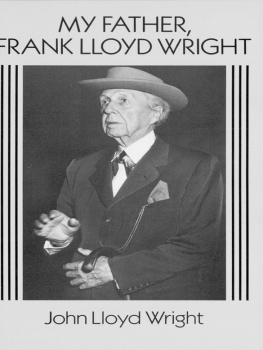
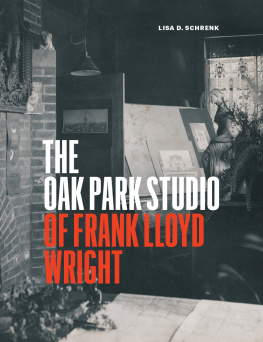
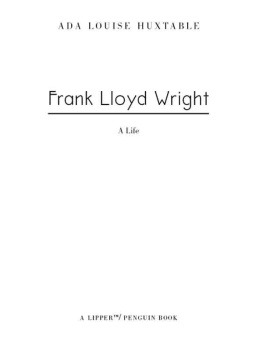

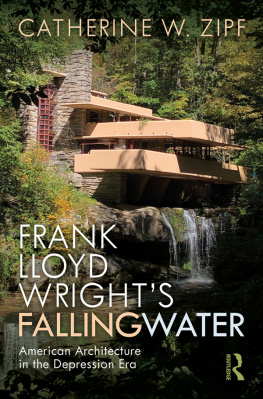
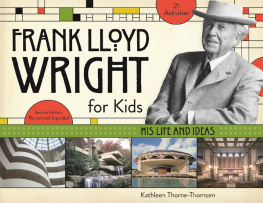
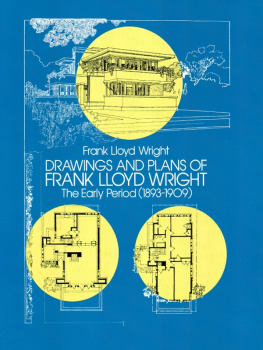

 This paper meets the requirements of ANSI/NISO Z39.48-1992 (Permanence of Paper).
This paper meets the requirements of ANSI/NISO Z39.48-1992 (Permanence of Paper).